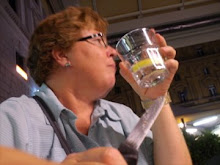Friday - the atmosphere dries out.
I am told that at one point today, the air temperature in Needles (CA) reached 106oF and at the same time the dew point temperature dropped to -14oF, yielding a dew point depression of 120oF!!! Close to a record, but not quite. But STILL!!!!!
Translation...some really dry air had moved in (as forecast and expected) from the west, thus shutting down chances of convection. In fact a few storms did brew up, some giving flash flooding out in the Wallow fire area, but none in FLG. So we designated today as an "instruments" day, and we had some good experiments planned.
As usual, the bleeping instruments were having a bad day. Do instruments ever work all the time??? Imagine having a laptop or desktop that only worked 30-50% of the time you turned them on! So the $180,000 radiometer - which is virtually brand new, and which had worked OK at SJSU, and which we had shipped out to FLG to leave in one location and gather a TON of atmospheric profile data - of course refused to work (just like the sodar in year 1). We did gather some data, namely the EXACT elapsed time after switch-on that the radiometer would die: 4.5 minutes. Nobody real happy.
Each year, we have brought one extra radiosonde system with us! This year we have added a Vaisala system to the GRAW and IMET systems. This gives plenty of opportunity for multiple launch-type experiments. Assuming everything works. Which usually, it doesn't. The high point was a launch at the same time as the official NWS FLG OOZ radiosonde launch - both profiles look very similar, including both showing a very dry layer up above about 500 hPa (encouraging!) The low point was a balloon snagging one of a million pine trees nearby on its way up. Reminded me of every Charlie Brown strip!
The day wasn't a complete loss, although the main plan had been to compare radiosonde (working) and radiometer (dead after 4.5 mins) soundings. After the OOZ launch, the students drove NW of FLG to set up a RAWS station which we will leave to get 24 hours of data. The data may or may not be exciting, but the experience of setting up the RAWS is good.
Oh - and I fell and bumped my head, saw stars, and decided to be on the safe side and spend a couple of hours at the ER making sure the brain is still working at fever pitch. Which - it is! I am sporting a nice bump on my head!!
Translation...some really dry air had moved in (as forecast and expected) from the west, thus shutting down chances of convection. In fact a few storms did brew up, some giving flash flooding out in the Wallow fire area, but none in FLG. So we designated today as an "instruments" day, and we had some good experiments planned.
As usual, the bleeping instruments were having a bad day. Do instruments ever work all the time??? Imagine having a laptop or desktop that only worked 30-50% of the time you turned them on! So the $180,000 radiometer - which is virtually brand new, and which had worked OK at SJSU, and which we had shipped out to FLG to leave in one location and gather a TON of atmospheric profile data - of course refused to work (just like the sodar in year 1). We did gather some data, namely the EXACT elapsed time after switch-on that the radiometer would die: 4.5 minutes. Nobody real happy.
Each year, we have brought one extra radiosonde system with us! This year we have added a Vaisala system to the GRAW and IMET systems. This gives plenty of opportunity for multiple launch-type experiments. Assuming everything works. Which usually, it doesn't. The high point was a launch at the same time as the official NWS FLG OOZ radiosonde launch - both profiles look very similar, including both showing a very dry layer up above about 500 hPa (encouraging!) The low point was a balloon snagging one of a million pine trees nearby on its way up. Reminded me of every Charlie Brown strip!
The day wasn't a complete loss, although the main plan had been to compare radiosonde (working) and radiometer (dead after 4.5 mins) soundings. After the OOZ launch, the students drove NW of FLG to set up a RAWS station which we will leave to get 24 hours of data. The data may or may not be exciting, but the experience of setting up the RAWS is good.
Oh - and I fell and bumped my head, saw stars, and decided to be on the safe side and spend a couple of hours at the ER making sure the brain is still working at fever pitch. Which - it is! I am sporting a nice bump on my head!!


0 Comments:
Post a Comment
Subscribe to Post Comments [Atom]
<< Home